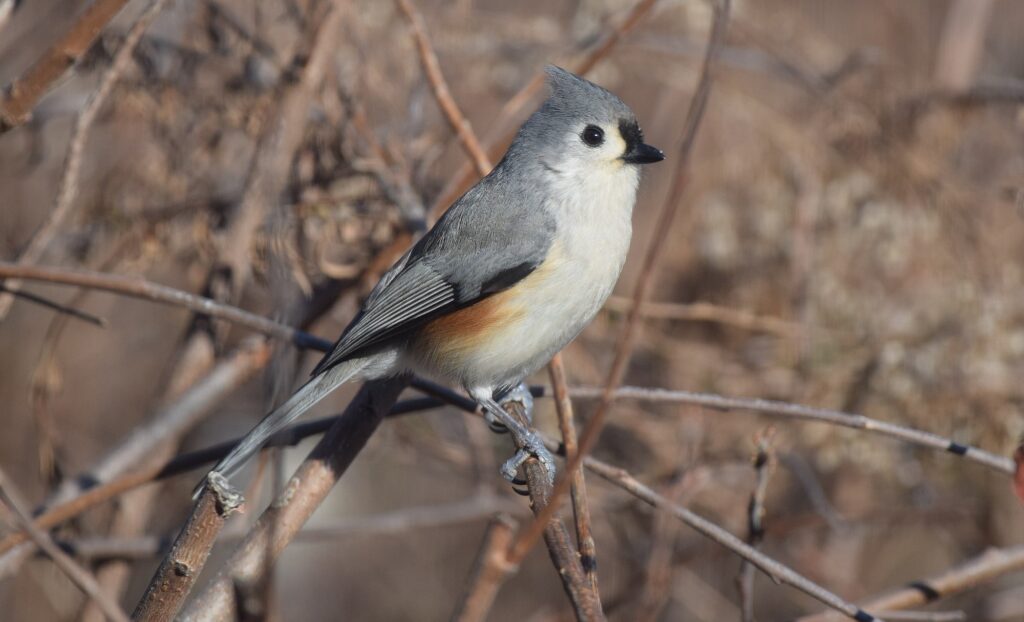
On a frigid morning in an otherwise mild winter in the city, I was standing near the western tip of Belle Isle, looking towards downtown Detroit. About halfway between the Ambassador Bridge and me, I could see a handful of dark spots floating on the water and then disappearing below the surface.
The wind stung my face and cut through my thick winter coat as I raised my binoculars. Those dark spots were transformed into a small group of little black and white ducks floating on and periodically diving into the river. The size and shape of their heads and their distinct markings told me they were buffleheads – visitors from Canada and Alaska that come south to warm up during the winter.
To these waterfowl, the Detroit River in February is their Miami Beach.
After a few moments, I spun on my heels and headed toward the warmth of my car. But then I caught sight of a few other out-of-town visitors near the James Scott Memorial Fountain.
A small flock of redhead ducks was puttering around the pond adjacent to the fountain, milling near the Canadian geese and mallards. It was nothing like the raft of nearly 7,000 redheads spotted on the Straits of Mackinac that grabbed headlines in December, but I was still glad to see them.
Winter may not seem ideal for birdwatching in Detroit, but the river provides prime habitat for some weird waterfowl. Belle Isle is a birding hotspot year-round, but in the cold months, it offers the chance to see some out-of-towners and familiar species that hunker down for the winter.
A refuge for the mind —or ‘How I got into birding’
Ask any birder or birdwatcher about what got them into birds, and they will almost always single out one species that burst the bird worldwide for them. It’s called a “spark bird” in the community, and the experience is so ubiquitous, public radio’s This American Life has an entire episode dedicated to spark bird stories.
The bird that did it for me was the belted kingfisher. I was out on a walk on a frigid February day, and heard what sounded like two stones being banged together in rapid succession. Then I saw a dark blue bird about the size of a bluejay with a long beak and wild hairdo swooping from a low branch over a partially frozen creek. I stood there awestruck for a few minutes, watching this bird I had never seen before dart and swoop, making that raucous rattle noise while in flight.

I finally identified it later that day, and it was all over for me. First came the field guide, then the binoculars. I go out birdwatching a couple of times a week. Eventually, I started my life list (a list of all the birds I had seen), and being a birder became a large part of my identity.
I began cultivating this new hobby like countless others during the darkest days of the pandemic lockdown. Making sourdough had little appeal, and I couldn’t afford a Peloton, but I found myself outdoors more and more, especially as spring began. I’m much more an enthusiast than an expert, but I relish in sharing my love for birds and the sense of wonder they give me.
Birding became a refuge from the insanity of the world. Quarantines, new variants, and attacks on democracy couldn’t reach me in the woods. The stress of the headlines melted away when I looked through my binoculars. I couldn’t make sense of the world, but I felt my mind clear each time I got into nature.
The appeals of birding are not hard to understand – at least for me. The benefits of being in natural spaces are well documented, forcing one to bring a degree of mindfulness to their nature walk.
If birding intrigues you, here are some tips from a relatively new Detroit birder:
Embrace your unicorn
As renowned birder Christian Cooper outlines in “Birders: The Central Park Effect” (a must-watch for anyone interested in birds in urban areas), birding combines science with scavenger hunting. Cooper beautifully lists his seven reasons for birding in the film, and I would be hard-pressed to improve upon them.
My favorite on Cooper’s list is what he calls the Unicorn Effect. After looking through field guides and watching videos online, some birds take on mythical status in your mind.
When you finally see one in the wild, it’s like you stumbled upon a unicorn. It’s also been likened to seeing a celebrity walking down the street.
Don’t worry about expensive equipment
Birding has relatively low barriers to entry. I’m sure it’s nice to drop thousands of dollars on a pair of binoculars or to get a camera lens as long as your arm, but it’s not necessary. I have a pair of binoculars that cost less than $60 and work wonderfully.
Binoculars are not even a necessity. One can enjoy observing birds with their eyes and ears alone. And it’s lovely to thumb through a field guide, but they can also get pricey. No disrespect to the Sibley or Peterson dynasties, but there are many free resources online from reputable sources with all the bird facts and identifying tips one needs.
Develop your ear
Birding is as much or more about listening as it is about seeing. April Campbell founded BIPOC Birders of Michigan and has this tip for beginning birders:
“Take your time and look at every bird. If a bird is singing or calling, be patient and try to get a look at the vocalizing bird, she said “That way, the bird and its corresponding sound will come together in your brain.”
Speaking of birdsong, the Cornell Lab of Ornithology has added a “Sound ID” feature to its identification app called Merlin in the last few years. It functions like a Shazzam for birds, taking a live recording that the user captures, running it through an algorithm, and telling you which bird or birds you hear with surprising accuracy. This app has become indispensable as I continue developing my ear for identifying birds.
Detroit Audubon’s program coordinator Brittany Leick also finds Merlin useful, even with university-level ornithology classes under her belt.
“Despite my schooling, I have struggled with audio identification for years and depend on Merlin to assist if I can’t pinpoint a bird around me. Some have the gift of audio learning, and others do not,” says Leick.
Respect birding ethics
Every new birder should also familiarize themselves with the ethics of birding. The American Birding Association’s Code of Ethics is a great starting point. My main concern when birding is avoiding any action that significantly influences a bird’s behavior. Some influence is unavoidable. Tufted titmice and chickadees will sound their alarm call almost any time I’m out on the trail. Actions like bird baiting, getting too close to nests, and approaching owls can place birds’ lives at risk.

Melissa McLeod (aka Feral Detroit) is an amateur naturalist, birder, and photographer based in Detroit. McLeod says birds and their habitat need our respect.
“Birds are not pokemon. They’re living, breathing beings. Learn about their habitat, what they eat, what they need to live,” she said. “One of the things birds need is space, especially urban birds. We have to respect their space and their habitat when we go out to watch them.”
Respect other birders
There is also a strong culture of gatekeeping among birders. As a relatively new birder, I’ve had people tell me I “didn’t deserve” to see a certain bird (a Mississippi kite hanging around Washtenaw County two summers ago, far outside its normal range) because I hadn’t been doing it long enough.
Birders should also respect others’ skills in identifying birds, or what bird brings them excitement. What might seem mundane to you could be life-changing for someone else.
“My biggest tip is to avoid getting caught up in traditional or competitive birding. Don’t go out with a target species; you’ll never be disappointed. Just take a walk and observe; you’ll learn so much more and connect on a much deeper level when you really pay attention and observe birds,” McLeod says.
Help birds
There are also ways we can help birds, especially during spring and fall migration. The thousands of miles between their summer breeding and overwintering grounds are perilous. Outdoor and feral cats pose the most significant danger.
The American Bird Conservancy estimates 2.4 billion birds are killed by cats in the United States annually.
It is a polarizing solution, but humans can help bring these numbers down by keeping their cats indoors. Window collisions account for another billion bird deaths each year. Some measures could reduce this number, including bird-friendly glass and ultraviolet stickers and paint one can apply to their windows.
Another way humans can help birds during migration is to reduce light pollution at night. Some of the largest population concentrations on the continent are along significant flyways for migratory birds. Buildings that remain lit 24 hours a day can confuse birds and result in their death.
Towns and cities of all sizes are starting to implement ordinances that require all government-owned buildings to turn off their lights during migration months, including in New York and Chicago. Advocacy groups are also working to bring these programs to privately owned buildings.
There is no shortage of ways to assist birds during migration or year-round. “If you want to support local birds, some of the best things you can do are keep cats inside, plant native plants, and don’t use pesticides,” says Detroit Audubon’s Landgraf.
Be aware of the migration
Most birds migrate after the sun goes down when the air is cooler and calmer, and they’re less visible to predators. The sheer number of birds in flight during night migration is so dramatic researchers can track their movements using radar.
BirdCast is a free platform developed by the Cornell Lab of Ornithology and allows users to see a projected three-day bird migration forecast, much like a weather app. In the spring and fall, BirdCast goes live and is a fantastic tool for birders and researchers. It also gives users a sense of how profoundly large migration is as a natural phenomenon.
Some insider tips on Belle Isle
Ava Landgraf is a research coordinator with Detroit Audubon. She looks forward to seeing the ducks and waterfowl that come to the Detroit River in winter.
“These ducks move a lot less than songbirds so you are less likely to miss them. Some of the species you can see on the Detroit River in winter are canvasbacks, redheads, common mergansers, hooded mergansers, and the very cute bufflehead,’ says Landgraf.
As winter hangs on for a few more weeks, there’s still time to see some of the seasonal visitors and the year-round inhabitants of Belle Isle. The trail that starts at the athletic fields is great for species that prefer trees and low brushy areas.
One can also access paths from the nature center that weave through some of the marshy areas on the island. To catch some of the waterfowl, check out Lakes Tacoma and Okonoka or the Blue Heron Lagoon, where you can usually see some hooded mergansers or goldeneyes.
Anywhere along the island’s perimeter or any of the fishing piers are good for spotting various duck species farther out in the river; I usually see a few bobbing in the channel near the Yacht Club and the long dock by the boat house.
But if you don’t want to brave the cold or the persistent wind coming off the river, things will thaw out soon. As the season changes, so do the cast of characters.
“It’s a great way to connect to the land and the seasons. No two days observing nature and birding are the same,” says McLeod. “There is always something new to see, to learn, or ways to dig deeper and new questions to ask.”

